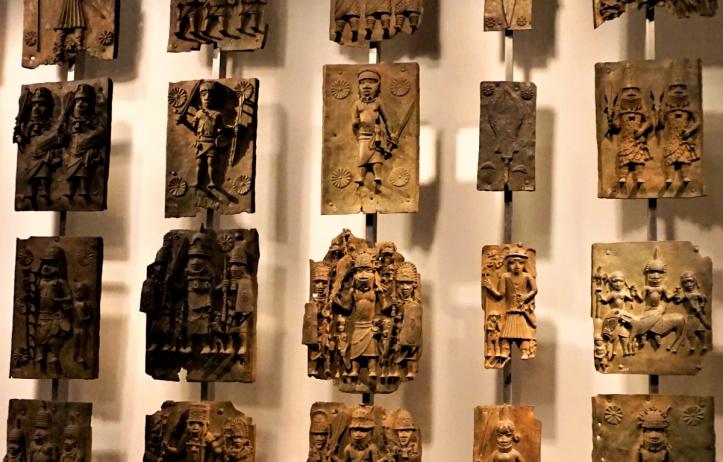Update on the Benin Bronzes: Research and Repatriation
In a previous blog post, ACE graduate assistant Courtney Pierce explained the cultural and historical significance of the Benin Bronzes. In 1897, British forces plundered some 4,000 items, not all made from bronze, from the Kingdom of Benin in present-day Nigeria. Through successive sales and donations, they have ended up in collections across the globe. In 2017, French president Emmanuel Macron pledged to explore “temporary or permanent restitution of African heritage,” a decision that intensified a worldwide conversation among academics and museum professionals about the Benin Bronzes. More recently, the combined effect of new publications on the items, heightened activism and the Black Lives Matter movement has increased public pressure on museums to repatriate the bronzes.
While restitution efforts have accelerated in the past five years, the work has been developing for decades. In the 1970s, the Nigerian government submitted formal claims to the British Museum calling for the return of the Benin Bronzes. It wasn’t until 2007 that museums in Germany, the United Kingdom, the Netherlands, Austria and Sweden collaborated with Nigerian officials to form the Benin Dialogue Group (BDG). The goal of the BDG is to display looted Benin artworks in a royal museum in Benin City, Nigeria—the original home of the Benin Bronzes. In 2019, the BDG announced that these plans are moving forward with a system of long-term loans to the Royal Museum of Benin City. This museum is now in development as the Edo Museum of West African Art under the architectural direction of Sir David Adjaye.
Dan Hicks, professor of contemporary archaeology in the School of Archaeology at Oxford University, has played a central role in bringing scholarly and public attention to this issue. His recent book, The Brutish Museums: The Benin Bronzes, Colonial Violence and Cultural Restitution (Pluto Press, 2020), examines the lack of provenance transparency in museums worldwide. Hicks argues that there is an inextricable link between colonial violence and capitalism, one which many institutions, intentionally or unintentionally, do not acknowledge. Hicks believes that the looting of cultural and sacred items from the African continent was not just a byproduct of colonialism, but created new means of domination and definitions of race through ethnographic exhibitions. Refusal to repatriate these items, he argues, is an implicit defense of colonial violence. According to Hicks, full repatriation, not long-term loan agreements, is the only way to rectify wrongs of the past.
Prior to the publication of The Brutish Museums, the Black Lives Matter movement also increased public interest in the return of the Benin Bronzes and other objects to their rightful homes. The murder of George Floyd in May 2020 sparked demonstrations worldwide, reviving the movement with a new fervor. In response to demonstrations against institutional racism, many museums made public statements that pledged to decolonize collections and repatriate objects that sourced from Africa. In May 2020, award-winning journalist Karen Attiah asserted in the Washington Post that these statements are empty and the work has yet to be done in the United States to return these artifacts. She states, “If Black Lives Matter to American museums, then restoring the dignity of the Black empires and their descendants need to matter, too.” Errol Francis, PhD, CEO of Culture&, agrees that many of these statements were “knee jerk” responses with little follow-through. Culture& published a Black Lives Matter Charter in response to last year’s events in July 2020, demanding that cultural institutions not only promote diverse and inclusive workplaces to support Black employees, but also decolonize collections by identifying and researching the provenance of items “which have been acquired by means of colonial aggression or with the profits of the transatlantic slave trade.” As one of the best known collections of art plundered from Africa, and the target of cultural appropriation for over a century, the Benin bronzes have been at the center of these discussions.
Amid mounting public pressure, some museums are repatriating the bronzes. In April 2021, the German government announced a collaboration with museums to return hundreds of Benin bronzes to Nigeria. This includes 200 items that were scheduled to go on display at the new Humboldt Forum in July 2021. In June 2021, the Metropolitan Museum of Art in New York returned a pair of Benin bronzes, making the Met one of few American museums to do so. In Scotland, the city of Glasgow is also making plans to restitute eight bronzes to Nigeria after over 30 years of repatriation requests. At this time, returned Benin bronzes will be displayed at the future Edo Museum of West African Art in Benin City, Nigeria— the former site of the Kingdom of Benin and the home of the Benin bronzes.
Closer to our own institution, a representative from the Denver Art Museum recently informed the Center for Art Collection Ethics that the museum is “closely evaluating all of the Benin objects in its collection to gather as many facts as possible so we may better understand their complete provenance.” The work at the Denver Art Museum is ongoing, and an incoming fellow in African art will assist in this research. At this time, the Denver Art Museum has not been contacted by the Nigerian government regarding any repatriation requests, and the museum is “approaching its research in good faith.”
Which institutions will be next? Stay tuned.
